Our attention seems to be limited by certain things, and cognitive psychologists attempt to explain how our focus works using selective attention theories.
Take a moment to think back to the last time you were at a party. Can you remember every detail? No really. I mean, can you remember every person that was there, everything that was said, the color of the tables, the size of the silverware, the type of flooring that you walked on, all of the smells…?
There are so many stimuli around us at every moment of the day. Even when you are sitting at home on your computer, there are always new sounds to take in or small details that you might not have noticed before.
The brain can’t take in all of the stimuli around you at once. You can’t focus on every sound, sight, smell, taste, and feeling occurring at a particular time. So your brain has to choose which stimuli it will focus on and what it will process.
...but how does that process work?
In this video, we’ll explain the basics of Selective Attention Theory. Psychologists have understood, without experimentation, that we can only pay attention to a limited set of stimuli simultaneously. However, the process of choosing stimuli and what happens to the rest has been up for debate throughout the scientific community over the years.
Colin Cherry (1953)
Colin Cherry noted that no matter how focused you were on one conversation if someone mentioned your name in another... you would be very likely to hear it. He called it the Cocktail Party Effect.
A Dichotic Listening Task is when a user listens to two messages in both ears. How, though, can we ensure that the person listening is truly trying to focus on the ear we ask them to?
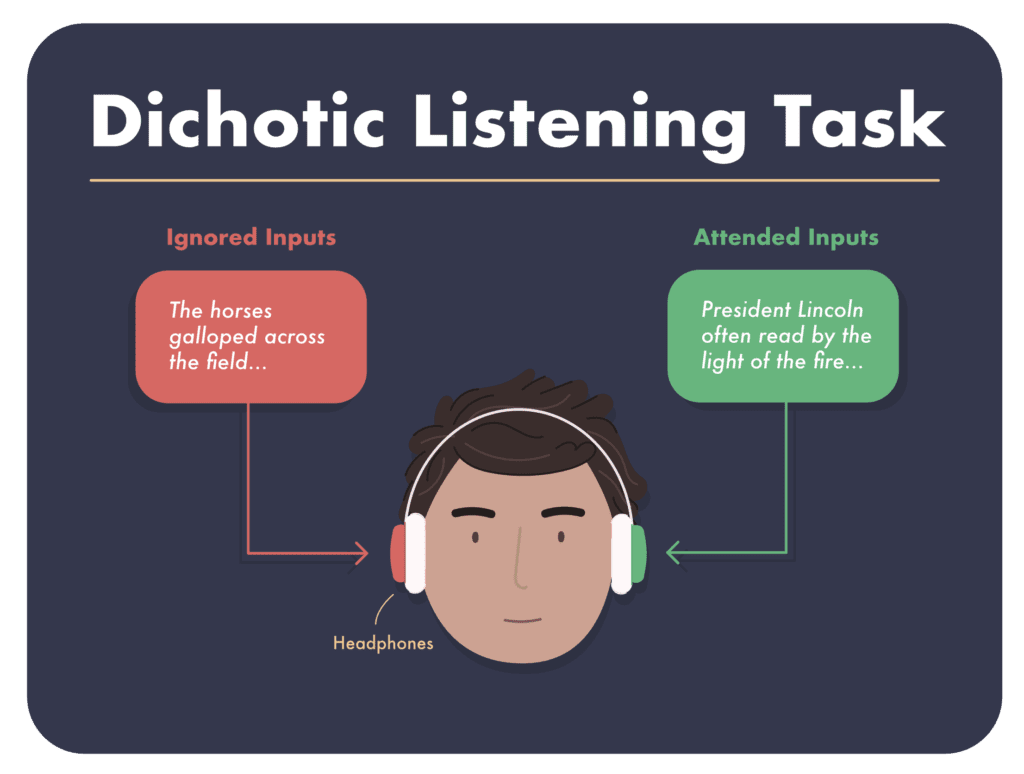
To continue his research, Cherry devised a method to study attention called Shadowing, in which listeners listen to two stimuli in each ear through headphones and are asked to say the message they are focusing on outline. The one they are asked to say aloud is called the "attended message," while the other is the "unattended message."
Why is shadowing important? It proves that the person is paying attention to a certain ear (we can be sure of their "mediational activity").
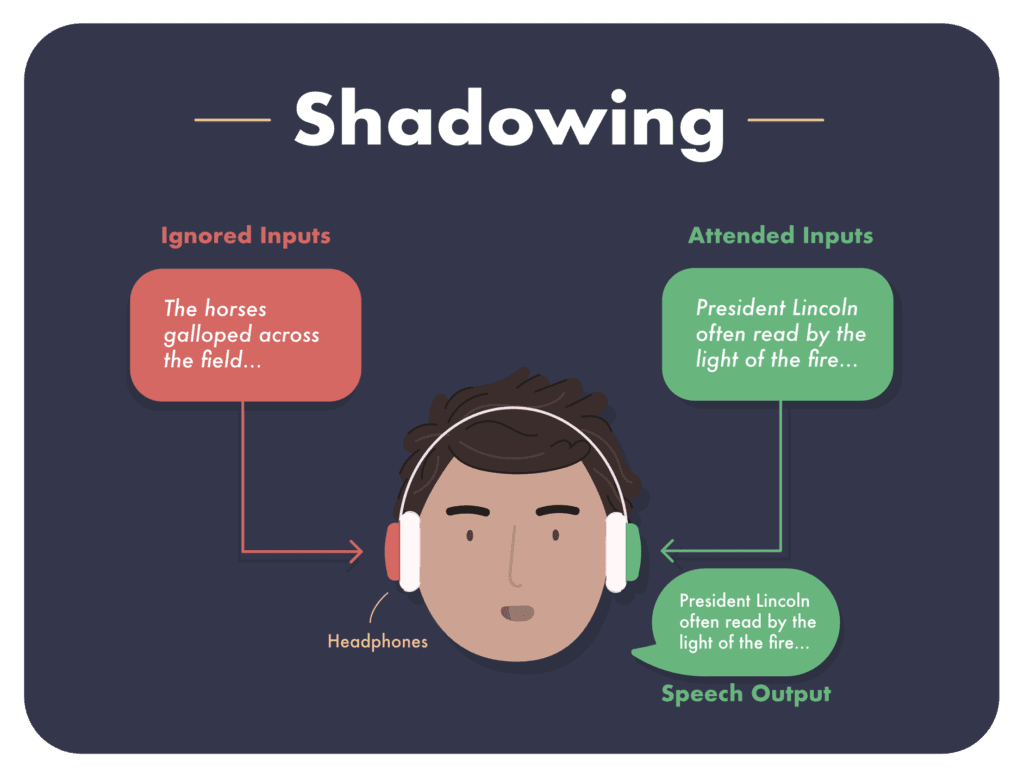
How much of the information is retained from the unattended message?
In most cases, only physical properties like volume and tonality were noticed. The participants didn't report noticing the change of the message's meaning, the language the message was spoken, the gender of the speaker, or even when the message was reversed. This led psychologists to believe unattended messages are filtered before meaning.
Broadbent's Filter Model (1958)
Donald Broadbent developed the first model for the function of attention. Broadbent theorized that sensory organs took in the information and that the information was then funneled through a "bottleneck" where only a small portion of the overall information reached our working memory.

The "Filter" that Broadbent theorized could focus on specific physical characteristics such as the tone or pitch of a sound. Picture a long glass bottle with the bottom cut out. All input is entered through the large bottom, but the selective filter moves only some information through the small opening at the top. The rest of the information is completely blocked and never understood by the brain. After information passes through this filter, it then passes on to what he called a "Detector."
The Detector processes higher-level parts of information, like meaning.
Once we can understand the meaning of something we focus on, it then gets stored in short-term memory, where it could pass further into long-term memory. Broadbent's Filter model is classified as an "Early-Selection" model since it filters simple characteristics before it processes meaning.
Broadbent did not give his participants instructions to shadow the information that entered their ears, nor did he instruct them to shadow the information.
Moray (1959)
Moray retested some of the dichotic listening tasks that Cherry had created with a more rigorous and academically sound eye. What did he find? More people could recognize words they focused on during the task than the words they "blocked' unless those words were important to the person, like their name.
As you can already tell, The Cocktail Party effect shouldn't have happened if Broadbent's model was completely correct because Broadbent claims meaning is processed last. This is hole #1.
Dear Aunt Jane experiment (1960)
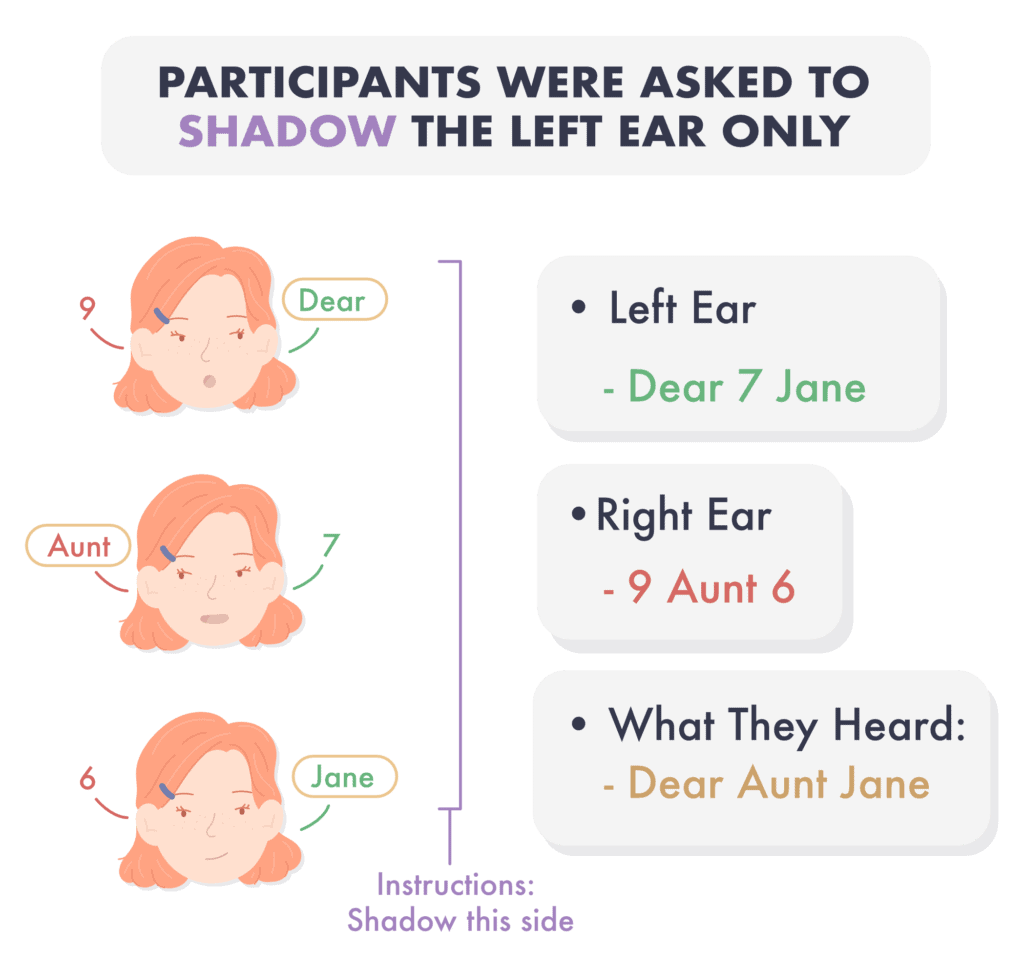
There was a famous experiment performed after Broadbent published his model called the "Dear Aunt Jane" experiment in 1960 (Gray & Wedderburn). Participants were asked to only listen to their left ear. Here's the information that was given to them in each ear:
Left Ear: Dear, 7, Jane
Right Ear: 9, Aunt, 6
Did they hear "Dear 7 Jane" like they were supposed to? No. The participants overwhelmingly reported hearing "Dear Aunt Jane," which shows that sometimes we process meaning before physical characteristics. This is a problem in Broadbent's model. Somehow, we pay more attention to the words than the numbers. This is hole #2.
Treisman's Attenuation Model (1964)
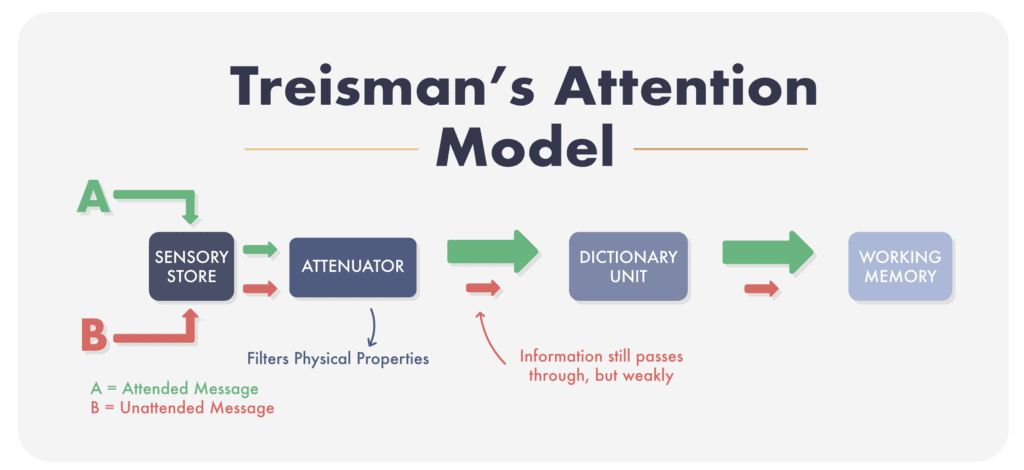
Interestingly, a student of Broadbent, Anne Treisman, continued his work and attempted to fill the holes in his theory. Sometimes psychologists refer to this model as the "leaky filter model" of attention, and similar to Broadbent's, it is classified as an early-selection process.
Treisman said that within the filter of Broadbent's model, there were also two new parts: an "Attenuator" and a "Dictionary unit."
Once information hits the attenuator, it analyzes information based on:
- Physical Characteristics
- Language
- Meaning
However, the processing is hierarchical, meaning language and meaning are only used if the physical characteristics are unclear. Treisman theorized that both information that we focus on and information we don't focus on can also pass through if the meaning is important enough. Imagine the attenuator like a volume knob, which can turn up the volume on certain stimuli and down on others.
After the information is passed through the attenuator/filter, it goes into the "Dictionary unit," where every word has a different threshold for being activated. For example, common words like your own name have a low threshold, while "Rutabaga" has a high threshold. Treisman's Dictionary Unity is very similar to Broadbent's Detector.
According to Treisman, if someone says our name in another conversation, we will barely hear it because a small portion of that information is passed through the attenuator. Then, since we realized it was important, we "turned the volume up" and listened for that person's voice again to see if they were talking to us.
Factors like context, recognition, and the importance of the subject all play a role in how far stimuli get in this process. Not all of the input will be processed or moved onto working memory - after all, we only focus on a limited set of stimuli to prevent overwhelming the brain.
The Invisible Gorilla Experiment is great supporting evidence of Treisman's Attenuation Model. We "turn down" the gorilla because it has no meaning to us when we are counting the basketballs.
Deutsch and Deutsch (1963)
In 1963, Deutsch and Deutsch theorized a late-selection model, which supposed that all information is selected for meaning analysis. After analyzing the meaning, the brain picks which parts are relevant and focuses on those.
We also call this the pertinence model of attention. Deutsch and Deutsch believe you'll process the meaning of the information first; then, you'll decide if it's important. If it is, you'll pick those parts that are relevant and store them in short-term memory.
Norman's Pertinence Model (1969)
Norman took Deutsch and Deutsch's theory and refined it. One of the problems with Deutsh and Deutsch's theory was that unattended information is lost very quickly. Norman theorized that this is probably because short-term memory lasts only seconds without rehearsal. He found participants could remember the last few words of an unattended message if he asked them immediately after.
MacKay's (1973)
Donald MacKay performed some interesting studies on attention, specifically on late-selection models.
First, participants were set up with a dichotic listening task.
In the ear they were supposed to be paying attention to, they heard ambiguous sentences. "They were throwing stones at the bank." Is it a money bank or a river bank?
In the other ear, they heard "river" or "money." Remember, they were asked to ignore these words.
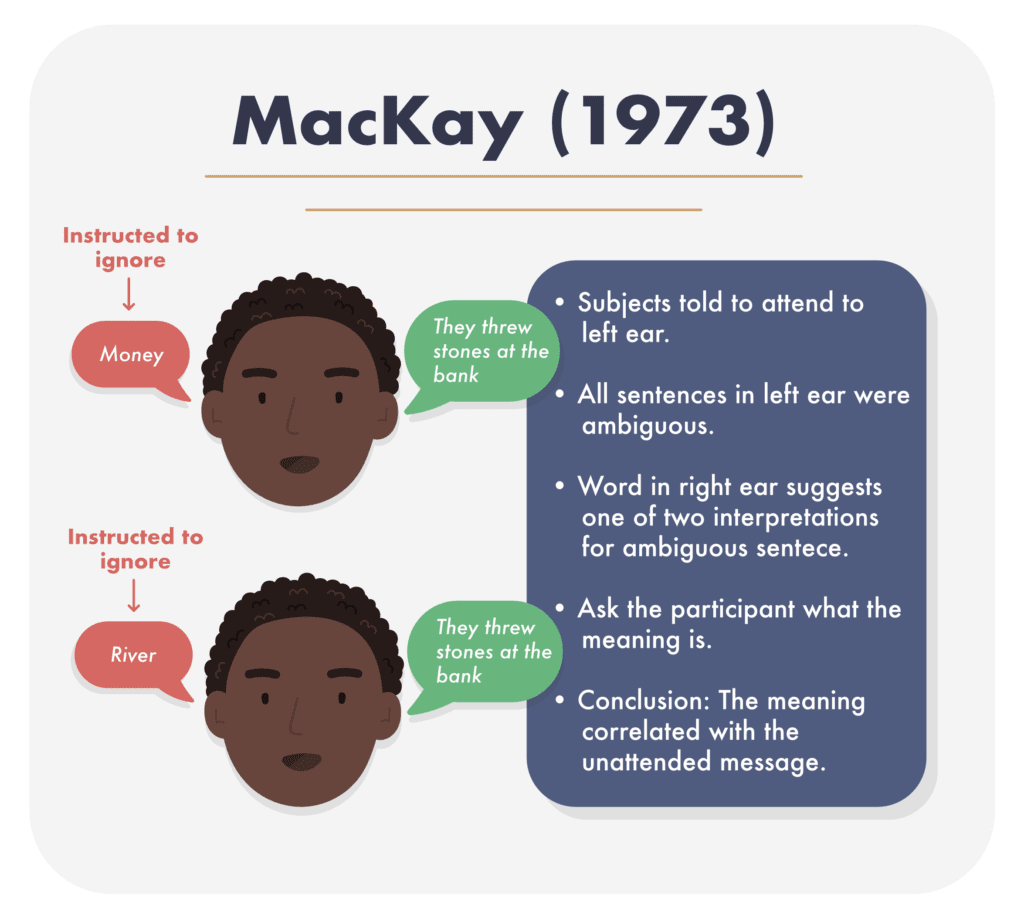
After they listened to both, they were asked to choose the closest meaning of the message they listened to.
They threw stones toward the side of the river yesterday.
They threw stones at the savings and loan association yesterday.
The results went exactly as you'd expected. Somehow, our brain can grab the meaning of messages we aren't even listening to and try to fit them in with what we hear. This proves that we follow a late-selection model, which means the filter of our attention is after the meaning is processed.
Johnston and Heinz (1978)
Later in 1987, two psychologists proposed a "multimode theory," which viewed attention as flexible and meant that we could filter out irrelevant information at any point. However, we are bottlenecked by our own processing ability, capacity, and effort.
Cowan (2009)
Something important to remember is that in 2009, a study showed that lower working memory capacities result in a worse ability to focus. This is important because it shows attention may be tied to intelligence since working memory and intelligence are also closely correlated.
Reticular Activating System (1949)
This concept dates back long before many selective attention theories, but it's one I want to mention due to its role in focus and attention. In 1949, Morouzzi and Magoun first introduced the idea of the reticular activating system, a bundle of neurons that plays a huge role in sleep, wakefulness, and brain activity. Essentially, the RAS chooses what information we pay attention to and what we ultimately ignore.
Have you ever heard a new word, and suddenly, you're hearing it everywhere? The same goes for a new TV show or concept in psychology. We can blame the Reticular Activating System for picking up on this new word now that you have interacted with it.
Psychologists have studied how the Reticular Activating System influences sleep cycles, but others have questioned how this system can influence how we perceive the world. If we are looking for positive opportunities, might our RAS bring our attention to positive opportunities? If we only look for excuses, are we shown them over opportunities? Might this explain the Cocktail Party Effect? Our minds may be more likely to filter out the noise and bring our name to the forefront of our minds.
There are a lot of theories that explain why we pay attention to certain things and ignore others!
